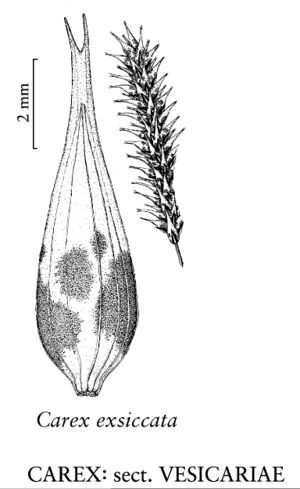Difference between revisions of "Carex retrorsa"
Ann. Lyceum Nat. Hist. New York 1: 71. 1824.
imported>Volume Importer |
imported>Volume Importer |
||
| Line 54: | Line 54: | ||
|publication year=1824 | |publication year=1824 | ||
|special status=Illustrated;Endemic | |special status=Illustrated;Endemic | ||
| − | |source xml=https:// | + | |source xml=https://bitbucket.org/aafc-mbb/fna-data-curation/src/2e0870ddd59836b60bcf96646a41e87ea5a5943a/coarse_grained_fna_xml/V23/V23_945.xml |
|genus=Carex | |genus=Carex | ||
|section=Carex sect. Vesicariae | |section=Carex sect. Vesicariae | ||
Latest revision as of 21:44, 5 November 2020
Plants cespitose; rhizomes very short or inconspicuous. Culms trigonous in cross section, 10–105 cm, smooth distally. Leaves: basal sheaths dark reddish brown; ligules longer than wide; blades mid to dark green, flat to W-shaped, widest leaves 3–10 mm wide, glabrous. Inflorescences 3–20(–35) cm; proximal bract 19–70(–100) cm, (2.5–)3–9 times longer than inflorescence; proximal (2–)3–6 spikes pistillate, ascending to spreading, at least the distal erect, ca. 20–150-flowered, cylindric; terminal 1(–3) spikes staminate, slightly if at all elevated beyond summit of crowded pistillate spikes. Pistillate scales narrowly ovate, 2.4–4.5 × 1.1–1.8 mm, shorter than perigynia, margins entire, apex acute to acuminate, awnless. Perigynia mostly reflexed at maturity, often green or straw colored, strongly 6–13-veined, veins running into beak, ovate, 6–10 × (1.6–)2.1–3.4 mm, apex abruptly tapered; beak 2.1–4.5 mm, bidentulate, smooth, teeth straight, 0.3–1.1 mm. Stigmas 3. Achenes pale brown, symmetric, not indented, trigonous, smooth.
Phenology: Fruiting Jun–Aug.
Habitat: Swamps, wet thickets, often along streams, marshes, sedge meadows, shores of streams, ponds, and lakes
Elevation: 0–1900 m
Distribution

B.C., Man., N.B., Ont., Que., Sask., Conn., Idaho, Ill., Ind., Iowa, Maine, Mass., Mich., Minn., Mont., N.Y., Oreg., Pa., Utah, Vt., Wash., Wis., Wyo.
Discussion
Very rarely, specimens appear to be intermediate between Carex retrorsa and C. lupulina or C. lupuliformis; they are likely hybrids.
Selected References
None.
